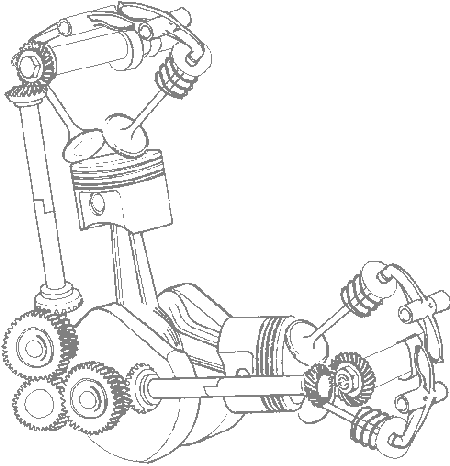
|
Vertical Bevel-drive (camshaft)

Assignment
Vertical bevel-drives can of course, be adapted to any type of engine with one or more overhead cams, but they only really make sense in two cylinder V-engines. In this case, the control from the crankshaft must be
transferred to two lonesome cams, almost regardless of their angle. The bevel-drive takes up less space than the chain- or belt-drives. Nonetheless, it is still a very complicated affair.
Function
The last one to use the bevel-drive, was the Ducati company, in the motorcycle sector. Here they were not used with normal valve springs like those shown in the above picture, but were combined with Desmodromic valve control. Indeed, even without the Desmo, a precise valve control is achieved, without having the
problems of re-adjusting, or anything like that.
The connection between the two camshafts and the crankshaft is actually quite simple, provided enough space is available. Each shaft then only needs one bevel
gear, and the bevel-drive shafts need two. In addition, one must be certain that the ratio of 2:1 from the crankshaft to the respective camshaft, is adhered to. If you take a look at any individual bevel-gear-drive, what
you'll see is, one small input gear and one large output gear.
In the present case, both camshafts would not have been able to mesh directly with one crankshaft-gear. Indeed, the bevel-gears in the cylinder head
would also have been too big. Therefore, one has realised at least a part of the ratio of 2:1 on the crankshaft, only then directing the torque to the vertical bevel-drives. If the two are now, as is usual in the V-engine, offset by the width of the connecting rod, the two cylinder heads and their camshafts can either be identical
or can be a reflected image of each other.
Important
The specifics of the linear expansion between the crankshaft and the cylinder head must be observed during the construction of bevel-drives. The two shafts in the picture are accordingly divided and suitably designed
for the transfer of torque.
History
The vertical bevel-drive can look back on a long tradition. As far back as 1909, a four-cylinder engine with bevel-drive was built by the Gasmotorenfabrik (gas engine factory) Deutz. Even somewhat earlier, there was a
construction in Nesseldorf (previously Austria, now the Czech Republic). 12/11
|
|